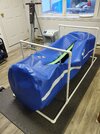During my visit to France, I did 25 sessions in the HBOT. Thank you for this opportunity.
What I noticed in the first 2 sessions, my ears hurt and I had to adjust the pressure. Instead of taking 10 minutes, I took 20 minutes. And the same time to lower the pressure again at the end. That helped.
After 3 days, my ears were clogged all day. This lasted about 2 weeks. I stopped for 2 days the HBOT and when I started again, my ears were fine. I could hear during the day. Ouf!
When I started again, I took the time to massage my ears, face, jaw, neck and head to relax the fascia. I did meditation and respiration. I felt much better afterwards. I continued to ear during the day.
I had different effects during the 25 HBOTs. I slept at first, then the circulation in my legs was better, my breathing during the sport was deeper without me controlling it. I feel happy in my heart and head to do HBOT.
Concentration was good. And what surprised me was that I began to understand English much better, with less stress.
when I came back, my ears were ok in the plane!
I'll try to find here (HBOT) to continues that processus. I did't find for this moment. It'll come.
What I noticed in the first 2 sessions, my ears hurt and I had to adjust the pressure. Instead of taking 10 minutes, I took 20 minutes. And the same time to lower the pressure again at the end. That helped.
After 3 days, my ears were clogged all day. This lasted about 2 weeks. I stopped for 2 days the HBOT and when I started again, my ears were fine. I could hear during the day. Ouf!
When I started again, I took the time to massage my ears, face, jaw, neck and head to relax the fascia. I did meditation and respiration. I felt much better afterwards. I continued to ear during the day.
I had different effects during the 25 HBOTs. I slept at first, then the circulation in my legs was better, my breathing during the sport was deeper without me controlling it. I feel happy in my heart and head to do HBOT.
Concentration was good. And what surprised me was that I began to understand English much better, with less stress.
when I came back, my ears were ok in the plane!
I'll try to find here (HBOT) to continues that processus. I did't find for this moment. It'll come.

 .
.



